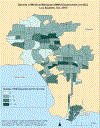Density of Medical Marijuana Dispensaries and Current Marijuana Use among Young Adult Marijuana Users in Los Angeles
- PMID: 31154889
- PMCID: PMC6681649
- DOI: 10.1080/10826084.2019.1618332
Density of Medical Marijuana Dispensaries and Current Marijuana Use among Young Adult Marijuana Users in Los Angeles
Abstract
Background: While tobacco and alcohol studies have focused on density of outlets as a determinant of consumption, research has begun examining the effects of medical marijuana (MM) dispensaries on marijuana use. Objectives: Examine the relationship between density of MM dispensaries and frequency of marijuana use among young adult medical marijuana patients (MMP) and nonpatient users (NPU). Methods: Young adult marijuana users (n = 329) aged 18- to 26-year old were sampled in Los Angeles in 2014-2015 and separated into MMP (n = 198) and NPU (n = 131). In 2014, 425 operational MM dispensaries were identified within the City of Los Angeles. Sequential multilevel Poisson random effect models examined density of MM dispensaries per square mile and 90 d marijuana use among MMP and NUP at the ZIP code level while controlling for demographic, behavioral, and community characteristics. Results: Density of MM dispensaries was not related to 90 d use of marijuana (days of use or hits per day) among either MMP or NPU. MMP reported significantly greater days of marijuana use in the past 90 d compared to NPU but no differences were found for hits per day. African-Americans reported significantly greater hits per day compared to whites. Hispanics reported significantly fewer hits per day compared to non-Hispanics. Conclusion: Concentration of MM dispensaries surrounding young adult marijuana users in Los Angeles was unrelated to days of marijuana use irrespective of having a MM recommendation or not. Rather, individual factors related to consumer choices and behaviors were more important in determining recent marijuana use among MMP and NPU.
Keywords: Medical marijuana; dispensary; young adults.
Conflict of interest statement
No conflicts of interest were reported by the authors.
Figures
Similar articles
-
Place over traits? Purchasing edibles from medical marijuana dispensaries in Los Angeles, CA.Addict Behav. 2017 Oct;73:1-3. doi: 10.1016/j.addbeh.2017.04.010. Epub 2017 Apr 7. Addict Behav. 2017. PMID: 28412327 Free PMC article.
-
Marijuana practices and patterns of use among young adult medical marijuana patients and non-patient marijuana users.Drug Alcohol Depend. 2017 Jan 1;170:181-188. doi: 10.1016/j.drugalcdep.2016.10.025. Epub 2016 Oct 26. Drug Alcohol Depend. 2017. PMID: 27987475 Free PMC article.
-
Examining the locations of medical marijuana dispensaries in Los Angeles.Drug Alcohol Rev. 2016 May;35(3):334-7. doi: 10.1111/dar.12325. Epub 2015 Sep 30. Drug Alcohol Rev. 2016. PMID: 26423794 Free PMC article.
-
Evaluating the Change in Medical Marijuana Dispensary Locations in Los Angeles Following the Passage of Local Legislation.J Prim Prev. 2017 Jun;38(3):265-277. doi: 10.1007/s10935-017-0473-8. J Prim Prev. 2017. PMID: 28455643
-
Who's Buying What and How Much? Correlates of Purchase Behaviors From Medical Marijuana Dispensaries in Los Angeles, California.J Prim Prev. 2018 Dec;39(6):571-589. doi: 10.1007/s10935-018-0528-5. J Prim Prev. 2018. PMID: 30414021 Free PMC article.
Cited by
-
Hours high as a proxy for marijuana use quantity in intensive longitudinal designs.Drug Alcohol Depend. 2022 Nov 1;240:109628. doi: 10.1016/j.drugalcdep.2022.109628. Epub 2022 Sep 9. Drug Alcohol Depend. 2022. PMID: 36126610 Free PMC article.
-
Accuracy Differences in Cannabis Retailer Information Ascertained from Webservices and Government-Maintained State Registries Across US States Legalizing the Sale of Cannabis in 2019.Cannabis. 2023 Jul 5;6(2):133-148. doi: 10.26828/cannabis/2023/000148. eCollection 2023. Cannabis. 2023. PMID: 37484053 Free PMC article.
-
Density of cannabis outlets vs. cannabis use behaviors and prevalent cannabis use disorder: findings from a nationally-representative survey.PeerJ. 2024 Apr 29;12:e17317. doi: 10.7717/peerj.17317. eCollection 2024. PeerJ. 2024. PMID: 38699183 Free PMC article.
-
Availability of medical cannabis dispensaries and cannabis abuse/dependence-related hospitalizations in California.Addiction. 2021 Jul;116(7):1908-1913. doi: 10.1111/add.15420. Epub 2021 Feb 10. Addiction. 2021. PMID: 33565655 Free PMC article.
-
Adolescent use and co-use of tobacco and cannabis in California: The roles of local policy and density of tobacco, vape, and cannabis retailers around schools.Prev Med Rep. 2023 Apr 7;33:102198. doi: 10.1016/j.pmedr.2023.102198. eCollection 2023 Jun. Prev Med Rep. 2023. PMID: 37223551 Free PMC article.
References
-
- Agresti A, & Kateri M (2011). Categorical data analysis. In Lovric M (Ed.), International encyclopedia of statistical science (pp. 206–208). Berlin, Germany: Springer-Verlag.
-
- Biernacki P, & Waldorf D (1981). Snowball sampling: problems, techniques and chain-referral sampling. Sociological Methods and Research, 10(2), 141–163.
Publication types
MeSH terms
Substances
Grants and funding
LinkOut - more resources
Full Text Sources
Medical
Miscellaneous

